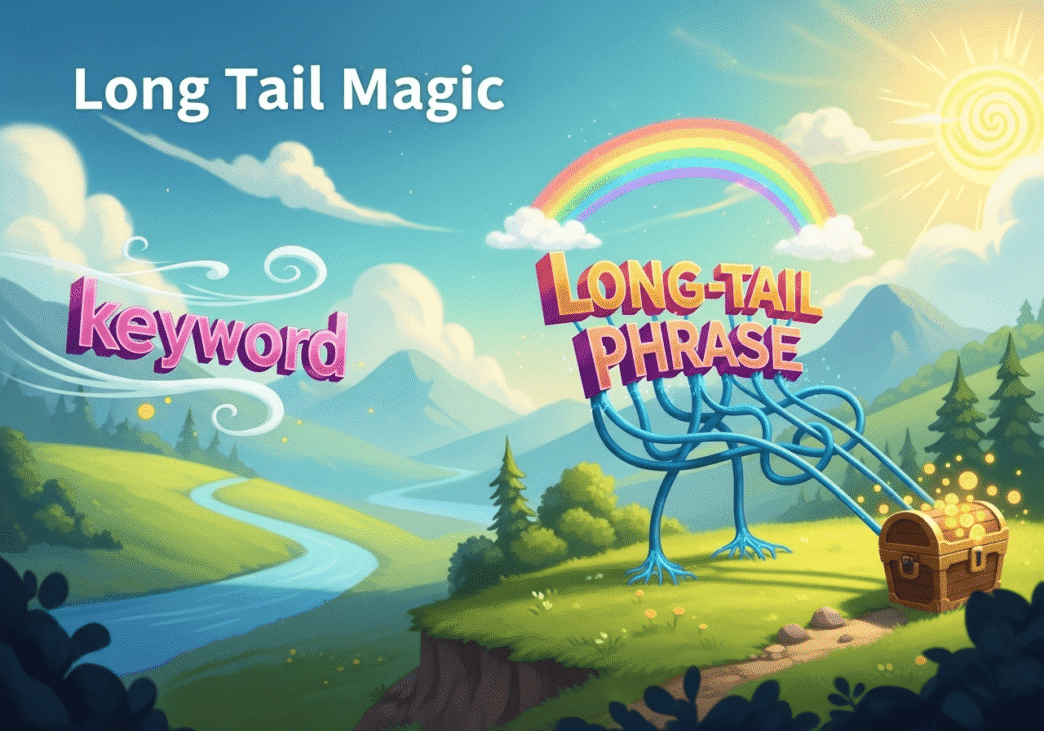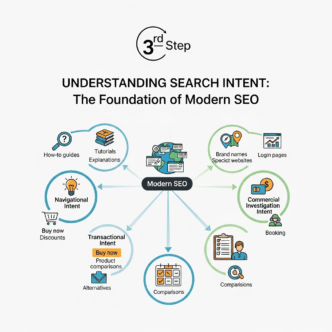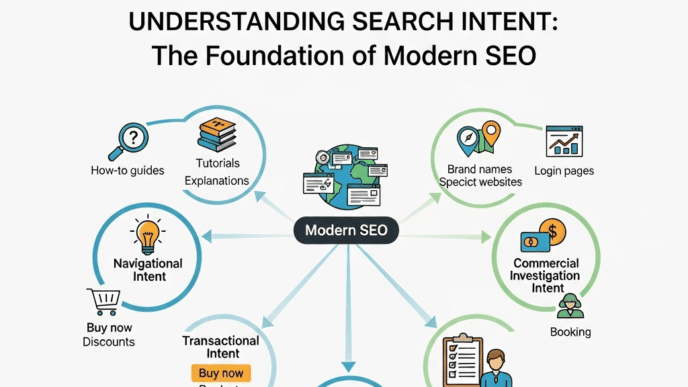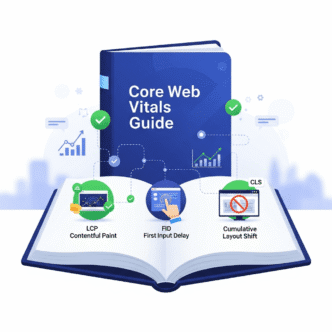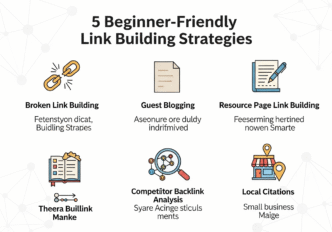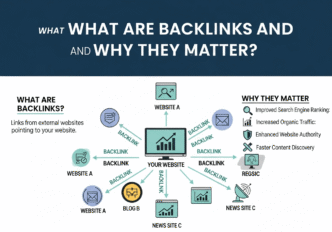Remember when you started your blog and thought ranking for “fitness” would make you the next internet millionaire? Yeah, me too.
Here’s the brutal truth: long tail keywords strategy isn’t just some fancy SEO buzzword your marketing guru throws around. It’s the difference between fighting Mike Tyson in his prime and arm-wrestling your little cousin. One’s going to leave you flat on the canvas, and the other might actually get you somewhere.
Let me guess – you’ve been throwing single keywords at your content like confetti, wondering why Google treats your website like it has the plague? Well, buckle up, because we’re about to flip your entire approach upside down.
Table of Contents
Toggle
What Exactly Are Long Tail Keywords (And Why Should You Care)?
Long tail keywords are simply longer, more specific search phrases that people type into search engines. Instead of “shoes,” think “comfortable running shoes for flat feet.”
These magical 3+ word phrases make up about 70% of all search queries. Yet most content creators ignore them completely. It’s like leaving money on the sidewalk because you’re too busy staring at the bank vault you can’t crack.
The beauty of long tail keywords? They’re easier to rank for, convert better, and actually match what real humans search for. When someone types “best budget smartphone under $300,” they’re not just browsing – they’re ready to buy.
How Do Long Tail Keywords Actually Work in Practice?
Think of keyword targeting strategies like fishing. Short keywords are like casting a tiny net in the ocean hoping to catch a whale. Long tail keywords? That’s using the right bait in the right spot where the fish actually swim.
Here’s what happens behind the scenes:
- Search volume drops (fewer people search)
- Competition plummets (fewer websites compete)
- Search intent becomes crystal clear (you know exactly what people want)
- Conversion rates skyrocket (targeted traffic converts better)
Let’s say you run a coffee blog. Targeting “coffee” puts you against Starbucks and every major publication. But “how to make cold brew coffee at home without equipment”? Now you’re talking to someone specific who needs your exact solution.
Why Do 3-Word Phrases Dominate Single Keywords Every Time?
Single keywords are like trying to have a conversation in a crowded stadium. Everyone’s shouting the same thing, and nobody can hear anything clearly.
Three-word phrases cut through the noise because they:
- Match natural speech patterns (how people actually talk and search)
- Reduce competition by 90% (most sites still chase broad terms)
- Increase relevance scoring (Google loves specificity)
- Boost click-through rates (users see exactly what they searched for)
The Competition Reality Check
| Keyword Type | Competition Level | Ranking Difficulty | Conversion Potential |
|---|---|---|---|
| Single Keyword (“fitness”) | Extreme | Nearly Impossible | Low (broad intent) |
| 2-Word Phrase (“home fitness”) | High | Very Difficult | Medium |
| 3-Word+ Phrase (“home fitness equipment for small spaces”) | Moderate | Achievable | High (specific intent) |
What’s the Secret Behind Successful Long Tail Keyword Research?
Effective keyword research techniques start with understanding your audience’s actual problems. Stop thinking like a business owner and start thinking like your confused, slightly desperate customer at 2 AM.
The goldmine lies in these question patterns:
- “How to [solve specific problem]”
- “Best [product type] for [specific situation]”
- “Why does [specific issue] happen”
- “[Product/service] vs [alternative] comparison”
Real-World Research Tools That Actually Work
Free options that don’t suck:
- Google’s “People Also Ask” sections
- Answer The Public (the question goldmine)
- Google Search Console (your own data treasure trove)
- Reddit and Quora (where people ask real questions)
Premium tools worth the investment:
- SEMrush for competitor keyword analysis
- Ahrefs for comprehensive keyword metrics
- Surfer SEO for content optimization
Pro Tip: The best long tail keywords often come from your customer service emails. Those frustrated questions your customers ask? They’re probably typing the same things into Google.
How Can You Find Long Tail Keywords That Actually Convert?
Conversion-focused keyword identification means looking beyond search volume to understand buyer intent. Not all keywords are created equal – some bring browsers, others bring buyers.
The Intent Pyramid looks like this:
- Informational intent: “what is content marketing” (top of funnel)
- Commercial investigation: “best content marketing tools” (middle funnel)
- Transactional intent: “hire content marketing agency Boston” (bottom funnel)
The Customer Journey Approach
Map your long tail keyword opportunities to where people are in their buying journey:
Awareness Stage:
- “Signs you need [solution]”
- “What causes [problem]”
- “Types of [product category]”
Consideration Stage:
- “Benefits of [specific solution]”
- “[Product A] vs [Product B]”
- “How to choose the right [service]”
Decision Stage:
- “Best [product] for [specific need]”
- “[Brand name] review and pricing”
- “Where to buy [specific product] near me”
Which Long Tail Keywords Should You Target First?
Strategic keyword prioritization isn’t about going after the shiniest keywords. It’s about finding the sweet spot between opportunity and effort.
Your priority matrix should consider:
- Relevance to your expertise (Can you create genuinely helpful content?)
- Search volume potential (Is anyone actually searching?)
- Competition analysis (Can you realistically compete?)
- Business alignment (Does it connect to your products/services?)
The Quick Win Formula
Focus on long tail keywords with:
- 100-1,000 monthly searches (sweet spot for new sites)
- Keyword difficulty under 30 (achievable with good content)
- Clear commercial or informational intent
- Direct connection to your expertise
| Priority Level | Monthly Searches | Keyword Difficulty | Time to Rank |
|---|---|---|---|
| Quick Wins | 100-1,000 | 0-30 | 3-6 months |
| Medium Opportunities | 1,000-5,000 | 30-50 | 6-12 months |
| Long-term Targets | 5,000+ | 50+ | 12+ months |
How Do You Create Content That Ranks for Long Tail Keywords?
Content optimization for long tail phrases is less about keyword stuffing and more about genuinely answering the specific question behind the search.
The magic formula:
- Use your target phrase in the title (naturally)
- Include it in your first paragraph (like we did here)
- Sprinkle semantic keyword variations throughout
- Structure content around the user’s actual question
The Content Structure That Google Loves
H2 and H3 headers should:
- Include question-based keywords naturally
- Follow a logical progression
- Address related search queries
- Use conversational language (how people actually talk)
Example content outline for “how to start a blog for beginners”:
- H2: What Do You Need Before Starting Your First Blog?
- H3: Choosing the right blogging platform for beginners
- H3: Domain name selection strategies
- H2: How Do You Set Up Your Blog Step by Step?
- H3: WordPress installation process
- H3: Essential blog plugins for new bloggers
What Mistakes Kill Your Long Tail Keyword Strategy?
The biggest blunder? Treating long tail keyword optimization like a math equation instead of a conversation with real humans.
Fatal mistakes I see everywhere:
- Keyword stuffing (shoving phrases where they don’t belong)
- Ignoring search intent (ranking for the wrong reasons)
- Creating thin content (500 words when you need 2,000)
- Forgetting about user experience (optimizing for bots, not humans)
- Not tracking the right metrics (obsessing over rankings instead of conversions)
The Recovery Strategy
When your long tail strategy isn’t working:
- Audit your content for natural keyword integration
- Check if you’re answering the actual question behind the search
- Analyze your bounce rates and time on page
- Look at what’s ranking above you (and why)
- Consider user search experience improvements
Pro Tip: If reading your content out loud sounds like a robot having a seizure, you’ve probably over-optimized. Scale it back and write for humans first, search engines second.
How Can You Track Long Tail Keyword Success?
Performance measurement for SEO goes way beyond just watching your rankings dance around. You need to track metrics that actually matter to your business.
Essential tracking metrics:
- Organic click-through rates (are people actually clicking?)
- Average session duration (are they sticking around?)
- Conversion rates by keyword group (which phrases bring buyers?)
- Featured snippet captures (the ultimate long tail win)
- Voice search optimization results (the future is speaking)
Tools for Tracking What Matters
Free tracking essentials:
- Google Analytics 4 (traffic and conversion tracking)
- Google Search Console (click-through rates and impressions)
- Google PageSpeed Insights (user experience metrics)
Premium tracking powerhouses:
- SEMrush Position Tracking (comprehensive rank monitoring)
- Ahrefs Keywords Explorer (competition and opportunity analysis)
What’s the Future of Long Tail Keywords?
The game is shifting faster than a caffeine-addicted squirrel. Voice search optimization and AI are changing how people find information, but the principles remain the same.
Emerging trends to watch:
- Conversational search queries (people talking to their phones)
- AI-generated search suggestions (smart assistants getting smarter)
- Local + long tail combinations (“best pizza near me for large groups”)
- Visual search integration (describing what they see)
The bottom line? Long tail keywords aren’t going anywhere. If anything, they’re becoming more important as search gets more sophisticated and personalized.
Your Next Steps
Ready to ditch the keyword casino and start playing smart? Here’s your action plan:
- Audit your current content for long tail opportunities
- Research 10-20 long tail phrases in your niche this week
- Create one piece of targeted content using these strategies
- Track your results for three months
- Scale what works and adjust what doesn’t
The best time to start your long tail keywords strategy was six months ago. The second best time? Right now.
Stop fighting for scraps at the broad keyword buffet. There’s a whole feast of targeted, conversion-ready traffic waiting for you in the long tail. And trust me – once you taste that sweet, sweet targeted traffic, you’ll never go back to the keyword hunger games..
Long Tail Keywords: 2025 Statistics Dashboard
Interactive data visualization showcasing the power of long tail keyword strategy
Keyword Strategy Comparison Matrix
Performance metrics across different keyword types
| Keyword Type | Competition Level | Ranking Difficulty | Conversion Rate | Voice Search Compatibility |
|---|---|---|---|---|
| Head Keywords (1-2 words) | Extreme (90-100% KD) | Nearly Impossible | 2-3% | Poor |
| Mid-Tail (2-3 words) | High (60-90% KD) | Very Difficult | 8-12% | Moderate |
| Long Tail (3+ words) | Low-Medium (10-40% KD) | Achievable | 36% | Excellent |
Long Tail Keyword ROI Calculator
Calculate the potential impact of switching to long tail keywords


